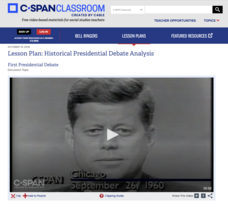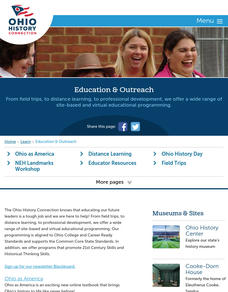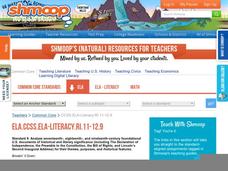Curated OER
Benjamin Franklin and the U.S. Constitution
Learners explore U.S. history by completing a quiz about civics. In this Benjamin Franklin lesson, students read assigned text about Franklin's role in the development of the Constitution and the creation of a new society. Learners...
Curated OER
Social Studies Strategies: Attribute Graph
In this exploring an attribute graph worksheet, students read information and observe an attribute graph about Cinderella, and complete a bar graph about the attributes of a historical figure or climax of events. Students complete one...
Curated OER
A New Birth of Freedom: Black Soldiers in the Union Army
Students investigate the history of civil rights by viewing historical photographs. In this U.S. history instructional activity, students discuss why Black Soldiers fought for their rights by joining the Union Army in the 1800's....
Curated OER
Structured Academic Controversy (SAC) in the History Classroom
SAC is a specific approach to discussing history and controversial issues. Rather than adhering to an either/or debate-style paradigm, it fosters speaking and constructivist listening to enable learners to build consensus through...
Curated OER
Witnesses to Joan of Arc and The Hundred Years' War
High schoolers trace Joan of Ar's history from early childhood through her death and on to her nullification trial. Joan's place in the history of the Hundred Years' War, what motivated her, enabled her, and brought about her demise is...
Curated OER
Little House in the Census: Almanzo and Laura Ingalls Wilder
How would you use census data from 1880-1900? Here are a set of ways you can incorporate the book Little House on the Prairie and US census data from that time period. Learners will research the validity or the book based on factual...
Code.org
The Need for Encryption
Scholars investigate the need for encryption as they read a portion of the book Blown to Bits and discuss encryption techniques. They finish by attempting to decode a message written using a Caesar cipher.
National Endowment for the Humanities
The Gulf of Tonkin Resolution and Escalation of the Vietnam War
The Gulf of Tonkin Resolution propelled America's involvement into a bloody conflict—and it was based on a fallacy. Using the resolution and other documents from the Vietnam War, including declassified documents, young historians...
Newseum
Today's Front Pages
Take a close look at a number of newspapers with collection of lessons and activities. Using a poster (which can be found under the materials tab), learners examine the hard copy of a local newspaper. This leads into an exploration of...
C-SPAN
Presidential Debate Analysis
The modern presidency is defined by the development of television—including the use of televised debates in the campaign. Using debates going back to the first one between John F. Kennedy and Richard Nixon, young scholars evaluate...
Curated OER
Life Grid: First Ladies Early Lives
While the resource won't seem like much at first glance, it could actually prove to be very handy. Learners fill in a grid that contains life facts on the Y-axis and the names of first ladies on the X-axis. Great for documenting facts...
Facing History and Ourselves
How Should We Remember?
We must remember the past in order to avoid its mistakes. Young historians analyze the importance of historical remembrance using primary and secondary documents, as well as video clips. They then study the creation of a World War II...
PBS
George Washington Carver: Scientist, Inventor, and Teacher
Using video clips along with primary and secondary documents, scholars analyze the life of George Washington Carver, one of America's best scientists and inventors. Class members then create music, posters, and skits about this amazing...
The Alamo
A Lesson in Citizenship
What does it mean to be an American citizen? Lieutenant Colonel Commander William Barret Travis believed that it meant honor to country first—even above one's own life. Middle and high schoolers read his final letters from the Alamo that...
American Museum of Natural History
Create Your Own Time Capsule
The corona virus pandemic is indeed a historic event. A time capsule activity permits young historians to document these days of social distancing, remote learning, and quarantine by collecting artifacts that capture what their lives are...
Curated OER
Making Cloth: The Impact of Technology
Young scholars analyze and discuss several primary source documents that address the changes in technology that affected New England agricultural communities in the early 19th century. They also identify and discuss historical contexts...
Curated OER
A Case Study: Slavery and Anti-Slavery in Philadelphia, PA, (17th-19th Centuries)
Eleventh graders work in teams of three. Each team visits a workstation to interpret, analyze, and apply information from documents for their final project. The final project is an exhibit at Independence National Historic Park
Shmoop
ELA - Literacy.CCSS.ELA-Literacy.RH.9-10.1
Do your pupils know what a primary source is? How about a secondary source? Provide them with the information here about different types of documents and then test their knowledge with a brief quiz. The quiz is made up of two documents....
Curated OER
Using Primary Source Documents
Learners examine copies of primary source documents and determine the document's value to a researcher. They analyze and evaluate the document for bias or contradiction. They know the difference between a primary and secondary source.
Curated OER
Understanding the Declaration of Independence
Students work in groups to do a document analyxix of several documents. Students view the Martin Luther King speech, "I Have a Dream." They discuss the Battle of Saratoge. Students give a personal view of the reason the Declaration of...
Curated OER
The Evolution of the Preamble
Reading and comprehending informational text is vital in all subject areas. Upper graders use primary sources and worksheets to better comprehend the historical importance of the Preamble of the US Constitution. Web links, handouts, and...
Curated OER
Reading Primary Source Documents: Comparing Sources
Students analyze and compare various primary source documents. They formulate historical questions based on the documents.
Curated OER
Dropping the Atomic Bomb: The Decision That Defined a Presidency
Students interpret historical evidence presented in primary and secondary resources. In this World War II lesson plan, students research the implications of the use of nuclear weapons to end the war in the Pacific. Students determine...
Shmoop
ELA.CCSS.ELA-Literacy.RI.11-12.9
Guided by close-reading questions, groups examine the similarities and differences between the Declaration of Independence and the Bill of Rights. In addition, they look at how the principles are presented in these two foundational US...

























